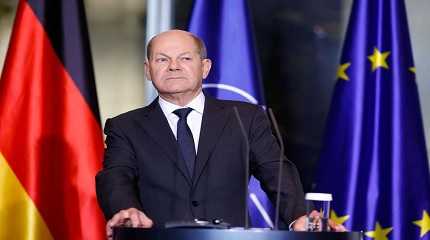
BERLIN (AP) — Nearly a year after Chancellor Olaf Scholz declared Russia’s invasion of Ukraine a “turning point” that would trigger weapons shipments to a nation at war and a massive increase in Germany’s military spending, the turnaround for his country’s armed forces still has a long way to go.
Germany has become one of the leading arms suppliers to Ukraine since the speech Scholz gave three days after Moscow sent troops into Ukraine. Lawmakers, including the main opposition bloc, gave strong backing in June to the 100 billion-euro ($107 billion) military procurement fund that the chancellor announced.
Over the weekend, Defense Minister Boris Pistorius said there had been “a 180-degree turn in the opinions of Germans regarding military questions, military issues, NATO and of course, what’s going on in Ukraine.”
A remarkable change in policy has indeed taken place in a country that, weeks before the invasion, drew derision for announcing that it would deliver 5,000 military helmets to Ukraine as a signal of solidarity. But some things have been slow to shift in Germany, whose history of World War II aggression led to an aversion to projecting military power.
Germany’s generosity in delivering weapons — it is Ukraine’s biggest supplier in continental Europe — has repeatedly been overshadowed by criticism of its perceived hesitancy in ramping up support, notably in clearing the way last month to supply battle tanks.
And much of the 100 billion euros in funding has yet to find its way into bolstering the German military, the Bundeswehr, which the army chief of staff, Lt. Gen. Alfons Mais, described on Feb. 24, 2022, as “more or less naked.” There is widespread acknowledgement that the military has suffered from years of neglect and in particular from aging, poorly functioning equipment.
Scholz pledged last February that “from now on, we will invest more than 2% of gross domestic product in our defense year for year,” a NATO target on which Germany has for years fallen significantly short, to the displeasure of allies such as the United States.
NATO figures from mid-2022 estimated the country would miss the benchmark again last year, with 1.44% of GDP going to defense.
Opposition leader Friedrich Merz complained to Scholz during a parliamentary debate this month that “large parts of the so-called ‘turning point’ that you described here on Feb. 27 last year so far are happening largely on paper in Germany.” Merz said it was unacceptable that “practically no orders” had yet been placed, particularly for ammunition.
It was mid-December by the time lawmakers gave the go-ahead for specific major procurement projects, including the purchase of 35 Lockheed Martin F-35 fighter jets, new assault rifles and radio systems. German defense companies have complained of seeing hardly any orders yet.
While there’s a wide understanding that Russia’s aggression marked a turning point, “it took a very long time to implement the changes in the German ministerial system, into the bureaucracy,” said Thomas Wiegold, a defense policy expert who runs the Augen geradeaus! military blog. “You have to say that, until now, it has not been really implemented.”
About 30 billion euros of the special fund has been committed to contracts for specific projects so far, Defense Ministry spokesman Arne Collatz said Wednesday.
There have been calls from some in and outside the military for a big increase in the special military procurement fund. But Wiegold noted that the fund doesn’t cover the military’s regular operations, including increasingly expensive basic costs such as fuel, and that billions need to be spent on ammunition.
“The main question is not to raise the special fund; the main question is what will be the defense budget, the regular budget, over the coming years,” he said.
Scholz, in a speech Saturday to the Munich Security Conference, an annual gathering of international security policy officials, stressed his pledge to get Germany’s defense spending up to 2% of GDP “permanently.”
Pistorius, who has brought new vigor to the Defense Ministry after his much-criticized predecessor quit last month, is reportedly pushing for a 10 billion-euro increase in the regular defense budget from the current annual level of around 50 billion euros.
“We will reach the 2% target, but we will also make every effort to go beyond that,” the minister said. “That will, of course, still have to be agreed in the (governing) coalition, but it must be clear to everyone that we won’t be able to fulfill the tasks that lie ahead of us with nearly 2% alone.”
That’s not an easy ask as Germany contends with the fallout from high inflation and the transition to renewable energy sources while also trying to keep a lid on government debt. “All of us would prefer to spend more money on other things, but reality is what it is,” Pistorius said.
There might be an easier fix for Germany’s image as a country that has to be prodded at every turn to step up its military aid.
“If you see the long list of what Germany has delivered, that’s pretty impressive,” Wiegold said. “At the same time, the German government is pretty, pretty bad in communications. ... If Germany would communicate better what it’s doing, this would help a lot.”




